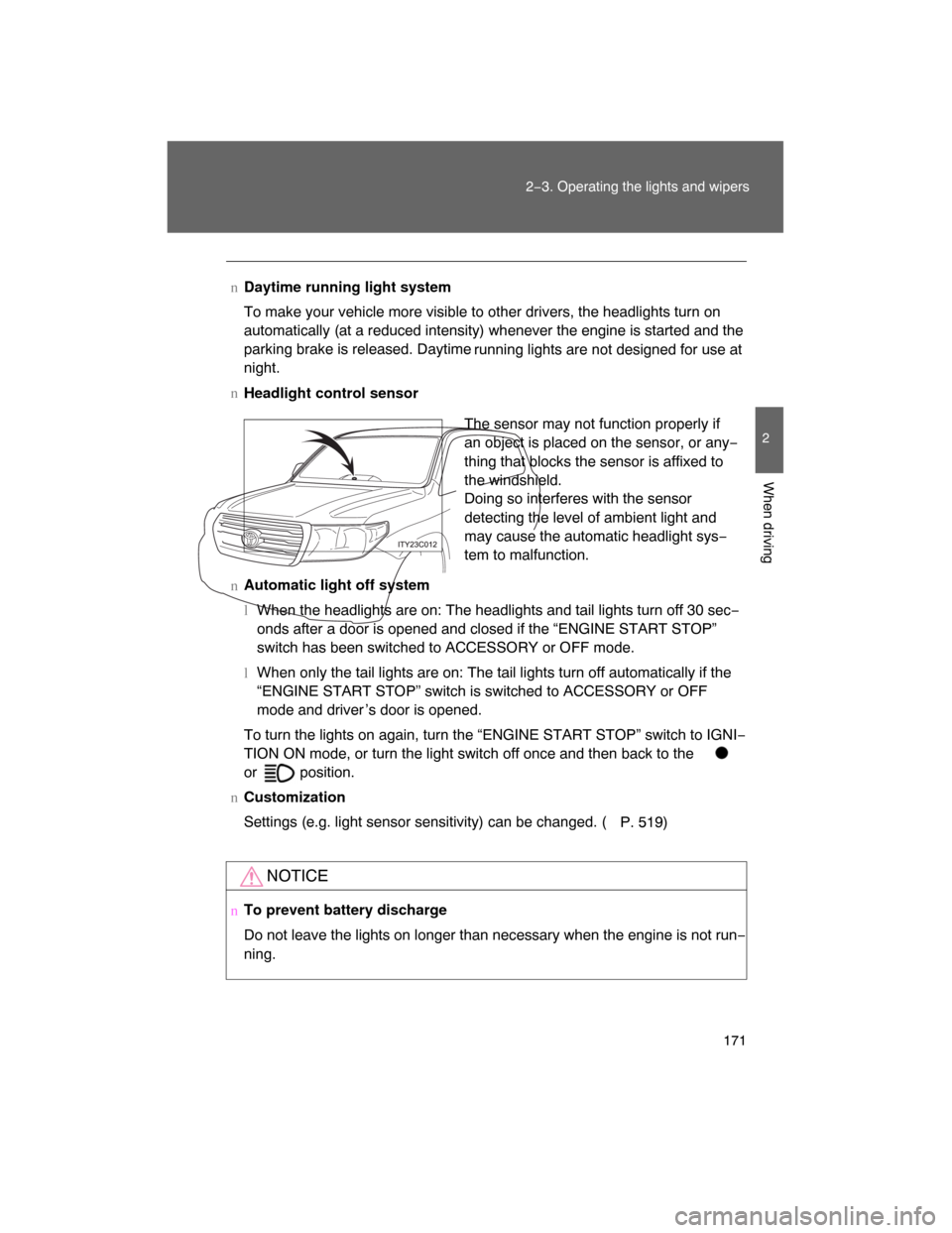Page 85 of 531
86
1−4. Opening and closing the windows and moon roof
Moon roof
Use the overhead switches to open, close, and tilt the moon roof up
and down.
nOpening and closing
Open
Stops just before it is opened
fully. Press the switch again to
fully open.
Close
To stop partway, press the
switch lightly.
nTilt up and down
Ti lt u p
Tilt down
To stop partway, press the
switch lightly.
Page 97 of 531

98 1−6. Theft deterrent system
nItems to check before locking the vehicle
To prevent unexpected triggering of the alarm and vehicle theft, make sure
of the following.
lNobody is in the vehicle.
lThe windows and moon roof are closed before the alarm is set.
lNo valuables or other personal items are left in the vehicle.
nTriggering of the alarm
The alarm may be triggered in the following situations.
(Stopping the alarm deactivates the alarm system.)
lA person inside the vehicle opens a door or hood.
lThe battery is recharged or replaced when the vehicle is locked.
n
Panic mode
nDeactivating or stopping the alarm
Do one of the following to deactivate or stop the alarm.
lUnlock the doors using the smar t key system or the wireless
remote control.
lStart the engine. (The alarm will be deactivated or stopped after
a few seconds.)
When is pressed for longer than
about one second, the headlights/tail
lights/emergency flashers will flash, the
front and rear interior lights will come on,
and an alarm will sound for about 60 sec−
onds to deter any person from trying to
break into or damage your vehicle.
To stop the alarm, press any button on
the wireless remote control.
Page 109 of 531

110 1−7. Safety information
CAUTION
nSRS airbag precautions
Observe the following precautions regarding the airbags.
Failure to do so may cause death or serious injury.
lThe driver and all passengers in the vehicle must wear their seat belts
properly.
The SRS airbags are supplemental devices to be used with the seat belts.
lThe SRS driver airbag deploys with considerable force, and can cause
death or serious injury especially if the driver is very close to the airbag.
The National Highway Traffic Safety
Administration (“NHTSA”) advises:
Since the risk zone for driver airbag is the first 2 − 3 in. (50 − 75 mm) of
inflation, placing yourself 10 in. (250 mm) from your driver airbag provides
you with a clear margin of safety. This distance is measured from the cen−
ter of the steering wheel to your breastbone. If you sit less than 10 in. (250
mm) away now, you can change your driving position in several ways:
�Move your seat to the rear as far as you can while still reaching the
pedals comfortably.
�Slightly recline the back of the seat.
Although vehicle designs vary, many drivers can achieve the 10 in.
(250 mm) distance, even with the driver seat all the way forward, sim−
ply by reclining the back of the seat somewhat. If reclining the back of
your seat makes it hard to see the road, raise yourself by using a firm,
non−slippery cushion, or raise the seat if your vehicle has that feature.
�If your steering wheel is adjustable, tilt it downward. This points the air−
bag toward your chest instead of your head and neck.
The seat should be adjusted as recommended by NHTSA above, while still
maintaining control of the foot pedals, steering wheel, and your view of the
instrument panel controls.
Page 125 of 531

126 1−7. Safety information
CAUTION
nChild restraint precautions
lFor effective protection in automobile accidents and sudden stops, a child
must be properly restrained, using a seat belt or child restraint system
depending on the age and size of the child. Holding a child in your arms is
not a substitute for a child restraint system. In an accident, the child can be
crushed against the windshield, or between you and the vehicle’s interior.
lToyota strongly urges the use of a proper child restraint system that con−
forms to the size of the child, installed on the rear seat. According to acci−
dent statistics, the child is safer when properly restrained in the rear seat
than in the front seat.
lNever install a rear−facing child restraint system on the front passenger
seat even if the AIR BAG OFF indicator light illuminates. In the event of an
accident, the force of the rapid inflation of the front passenger airbag can
cause death or serious injury to the child if the rear−facing child restraint
system is installed on the front passenger seat.
lA forward−facing child restraint system should allowed to be installed on
the front passenger seat only when it is unavoidable. Always move the
seat as far back as possible even if the AIR BAG OFF indicator light illumi−
nates, because the front passenger airbag could inflate with considerable
speed and force. Otherwise, the child may be killed or seriously injured.
lDo not use the seat belt extender when installing a child restraint system
on the front or rear passenger seat. If installing a child restraint system
with the seat belt extender connected to the seat belt, the seat belt will not
securely hold the child restraint system, which could cause death or seri−
ous injury to the child or other passengers in the event of collision.
lDo not allow the child to lean his/her head or any part of his/her body
against the door or the area of the seat, front pillar or roof side rail from
which the side airbags or curtain shield airbags deploy even if the child is
seated in the child restraint system. It is dangerous if the side airbags and
curtain shield airbags inflate, and the impact could cause death or serious
injury to the child.
l
Make sure you have complied with all installation instructions provided by
the child restraint manufacturer and that the system is properly secured. If
it is not secured properly, it may cause death or serious injury to the child
in the event of a sudden stop or accident.
Page 162 of 531
164 2−2. Instrument cluster
nIndicators
The indicators inform the driver of the operating state of the
vehicle’s various systems.
Turn signal indicator
(
P. 158)Roll sensing of curtain
shield airbags off indica−
tor (P. 116)
Headlight high beam
indicator (
P. 170)“PWR” mode indicator
(P. 154)
Headlight indicator
(
P. 170)Automatic transmission
second start indicator
(P. 154)
Fog light indicator
(
P. 172)Low speed four−wheel
drive indicator light
(P. 190)
Cruise control indicator
(
P. 178)Center differential lock
indicator (P. 203)
Slip indicator (
P. 202)“AIR BAG ON/OFF”
indicator (P. 117)
Crawl control indicator
(
P. 197)
*
**
*
Page 168 of 531
170
2−3. Operating the lights and wipers
Headlight switch
Turning on the high beam headlights
With the headlights on, push
the lever forward to turn on the
high beams.
Pull the lever back to the center
position to turn the high beams
off.
Pull the lever toward you to
turn on the high beams.
Release the lever to turn them off.
You can flash the high beams
with the headlights on or off. The headlights can be operated manually or automatically.
The side marker, park−
ing, tail, license plate
and instrument panel
lights turn on.
The headlights and all
lights listed above turn
on.
The headlights and all
lights listed above turn
on and off automati−
cally.
(When the “ENGINE
START STOP” switch is
in IGNITION ON
mode.)
ITY23C001
Page 169 of 531

171
2−3. Operating the lights and wipers
2
When driving
nDaytime running light system
To make your vehicle more visible to other drivers, the headlights turn on
automatically (at a reduced intensity) whenever the engine is started and the
parking brake is released. Daytime
running lights are not designed for use at
night.
n
Headlight control sensor
nAutomatic light off system
lWhen the headlights are on: The headlights and tail lights turn off 30 sec−
onds after a door is opened and closed if the “ENGINE START STOP”
switch has been switched to ACCESSORY or OFF mode.
lWhen only the tail lights are on: The tail lights turn off automatically if the
“ENGINE START STOP” switch is switched to ACCESSORY or OFF
mode and driver ’s door is opened.
To turn the lights on again, turn the “ENGINE START STOP” switch to IGNI−
TION ON mode, or turn the light switch off once and then back to the
or
position.
nCustomization
Settings (e.g. light sensor sensitivity) can be changed. (
P. 519)
NOTICE
nTo prevent battery discharge
Do not leave the lights on longer than necessary when the engine is not run−
ning.
The sensor may not function properly if
an object is placed on the sensor, or any−
thing that blocks the sensor is affixed to
the windshield.
Doing so interferes with the sensor
detecting the level of ambient light and
may cause the automatic headlight sys−
tem to malfunction.
Page 170 of 531
172
2−3. Operating the lights and wipers
Fog light switch
The fog lights improve visibility in difficult driving conditions, such
as in rain or fog. The fog lights can be used when the headlights are
on low beam.
Off
On
ITY23C014